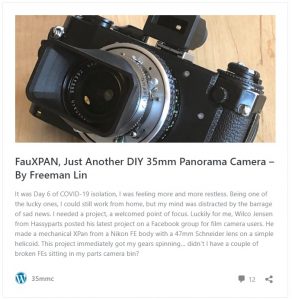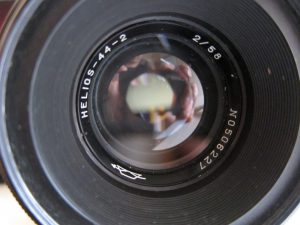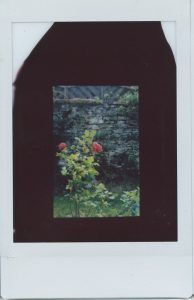 What if you were in the market for a Hasselblad XPan, but couldn’t afford a Hasselblad XPan, but had a broken Nikon FE, access to both a Sherline milling machine and a 3D printer, and a lot of free time? What would do?
What if you were in the market for a Hasselblad XPan, but couldn’t afford a Hasselblad XPan, but had a broken Nikon FE, access to both a Sherline milling machine and a 3D printer, and a lot of free time? What would do?
Build your own Hasselblad XPan/Nikon FE Franken-Camera, of course!
This week’s featured post is the camera hack to end all camera hacks, Freeman Lin from 35mmc shares a project done by Wilco Jensen from Hassyparts who did exactly that, and built his own DIY panoramic XPan. This is way beyond my capability or anything I doubt 99% of you would ever consider, but is an excellent example of what can be done with the right tools, time, and knowledge.
Using a Schneider Super Angulon 47mm f/8 lens mounted to a Syncro-Compur leaf shutter, a generic helicoid, and a host of 3D printed parts, Wilco Jensen was able to eek out an extra 4mm of width making panoramic photos a tad wider than what a real XPan makes.
The resulting camera looks professionally done and surprisingly doesn’t look out of place on the Nikon FE body. I don’t think that Wilco has any plans on making any others, but there’s just enough information and photos in this article to get you started if you have the talent and tools to try this on your own…and if you do, and want to let me borrow it, I’d love to write about it!
Here are more great posts from some of my favorite sites:
The 20th century camera industry was filled with partnerships and pairings where companies worked closely together with another for manufacturing or distribution. Nikon helped Canon build their first camera, the Hansa Canon, Ricoh built the Anscomark M for GAF/ANSCO, Mamiya built 35mm cameras for a bunch of companies, and Pentax cameras were sold as Heilands and Honeywells. This week, Eric from Aperture Preview takes a look at the partnership between Sears and Ricoh. Starting in 1962 with the original Ricoh Singlex, to later M42 SLRs and rangefinders, Eric shares some insight into the most successful Sears/Ricoh cameras, including my favorite, the Sears TLS with my all time favorite logo, the “atomic” SR logo.
Having recently reviewed the Minolta XE-7, I’ve been more interested in the Leica R3, a camera created in partnership between Leitz and Minolta. Conveniently, Luke Patton from 35mmc scratched that itch with his review of an R3 had received from his wife last Christmas. Even cooler, is he took it to a Disney theme park in California called Star Wars: Galaxy’s Edge. His behind the scenes shots of Chewbacca impersonators and Tattooine-esque scenes is cool enough, but his praise for the R3 has me really interested in getting one. As I type this, it’s only June, so that means I have a good half year to convince my wife to buy me a Leica R3 for next Christmas!
In what likely has generated him a ton of hate mail, this week Mike Connealy shares his experience in what he calls “CLA in a Can” where he uses an aerosol electrical contact cleaner to unstick the iris on his Kodak Retina Reflex. Retina Reflexes are notoriously complicated cameras that require the specialization of someone like Chris Sherlock to properly repair. But what if you just want to shoot one roll of film through a camera just to try it out and don’t want to invest the money and time into repairing it the right way. I’ve written on my site about how often I use lighter fluid or naphtha oil, but I’m going to have to try Mike’s suggestion and get some of this spray stuff and see if I can be just as successful in my next shade-tree mechanic repair session!
Jim Grey has been on a point and shoot kick lately, and his most recent review of the Canon Snappy S fits perfectly into that vague category of unremarkable plastic cameras with capable lenses from the 80s, 90s, and 00s. I honestly don’t even know when the Canon Snappy S was produced, but ultimately it doesn’t matter. Jim’s review validly points out one thing that collectors like me sometimes like to forget, which is that you don’t need a several hundred (or thousand) dollar camera to make nice photos. Sometimes a $1 thrift store find does a great job.
Two weeks ago, I shared a review of the Anscoflex, a twin lens box camera made by ANSCO in the 1950s by Aly’s Vintage Camera Alley. This time around, Alyssa takes a look at that camera’s sequel, the appropriately named Anscoflex II. As is the case with many sequels, the part deux can often be a rehash of the original with little to no improvements, but sometimes a sequel just as good or even better than the original. So which one is it. Is the Anscoflex II Fast and the Furious 2, or is it James Cameron’s Aliens?
Recently, there has been a rash of 3D printed digital light meters from a variety of companies to hit the market offering easy metering with an LCD screen for film photographers who want something a little more specific than Sunny 16. This week Alex Luyckx gives us his thoughts on the Reveni Labs LM-1, a small meter made in Canada that can still be purchased through Kickstarter. Many alternatives are Chinese made and of questionable quality. Is the Reveni worth your time and money?

One of the most popular vintage lenses by people looking for “swirly bokeh” is the Helios-44, a lens that was in production for over half a century in the Soviet Union and one that can be found cheaply and easily. This week Peggy Marsh from Camera Go Camera gives us her thought on a later Helios 44-2, but what’s different about her review than others is that while she attempted to get the signature look from this lens, she accidentally got some pretty good looking “normal” shots too. A lot of people seek out this lens for it’s bokeh, but ignore it as a pretty good and very inexpensive general purpose lens.
While reading Peggy’s article above about the Helios lens, she refers to a new blog called 35mm Retro Photo who she traded her Ensign Ful-Vue for a a Zenit 12 XP which someone named “John” reviews. Following that link to the Ensign review, I saw a promising new blogger that does an excellent job at giving his thoughts on the Ful-Vue along with some fantastic sample shots. The site was first created less than a month ago, so it is very new, but I am encouraged to read what John comes up with next!
I’ve read about both the Nikon F4 and Nikon F5, but despite being from the same “line” of professional single digit Nikon F-cameras, they represent two different eras. But what if you were in the market for a pro-level Nikon SLR with auto focus and could only afford one? Which one would you get? Luckily, this week, Jarrod Hills from Casual Photophile gives us an excellent comparison between these two excellent cameras. Comparing the two isn’t as straightforward as you might think, and Jarrod does an excellent job doing this, although the reality is, when deciding which of the two to buy, we all know the real answer is both!
If you live in Japan, Fuji’s Industrial 100 film isn’t anything remarkable, but if you live anywhere else, the thought of fresh Fuji 100 speed color film likely makes you salivate. Originally very hard to come by in the US, more and more importers (and eBay) are stocking it, making it more accessible to people like me. This week Kosmo Foto gives us a glimpse as to what this film can do. I’ve actually shot a roll of this myself in a review that will go live next week, so I’ll save my comments for then, but if you prefer a fine grained color film with neutral or somewhat muted colors, this imported film might be right for you.
I am no stranger to Kodak reviews on this site, having reviewed more Kodak models than any other single make, but there is a whole subset of Kodak cameras that were created solely for the European market which can’t easily be found here in the US. One such camera is the Kodak Colorsnap 35. This week Alan Duncan from Canny Cameras puts this camera, which looks to be a cross between a 1950s Brownie and a Kodak Pony through it’s paces. Although the camera wasn’t without it’s quirks, the results Alan got from it are promising and confirm my belief that Kodak was in the business of churning out cameras that were ‘good enough’ just to keep selling film. Color me impressed!

One of the many fun aspects of this hobby is all of the “hacks” that can be done adapting films with cameras that they weren’t intended to be used for. In most cases, we’re adapting modern films into formats like 828 or 620 that aren’t in production anymore, but in this week’s post by Jake Collinge from EMULSIVE, he adapts Instax film into a 35mm camera. You can still buy Instax and 35mm film so some might question why anyone would do this, but to that, I would say, why not?!
In a second review by Peggy Marsh, this time she looks at the strangely named Konica Genba Kantoku DD, a rugged “site supervisor” point and shoot camera from the 1990s. For reasons I’ve never been able to discover, there was a short lived increase in popularity of Japanese camera makers who made these incredibly rugged job site cameras that were sold in Japan only. Konica, Fuji, and Canon all had their own variants on the same theme. A mostly plastic and rubber body with some level of water tightness, a fixed focus fast lens, and oversized simple controls, the Genba Kantoku DD is an imposing little point and shoot that is rarely found in mint condition. My only experience with a camera like this is the Fuji K-28 which I have yet to review, but after seeing Peggy’s results, I need to hurry up with that one!
This next post is from May of last year, but I only recently discovered it and thought it was worth sharing as I love shooting old expired film. For anyone whose done it though, sometimes the results are unusable due to something called base fog. I’ve read a little bit about how to reduce it, but this post from Daniel Keating on DIY Photography is the best I’ve seen showing a home brew solution for making usable film out of otherwise unusable film stocks. Daniel shows before and after results using a radiology film called Kodak CFX 5538 and his results are impressive!
Returning with a music related recommendation, I have something that’s hopefully different enough for you to check out. Reaction videos on YouTube are all the rage these days and they all have a similar formula of someone watching or listening to a video or song for the first time by an artist that they are not familiar with.
This video is from a series of reaction videos by Pastor Robert Houghton and his son Gauge where they react to various heavy metal songs and give a thoughtful discussion on the lyrics and themes within the songs and how they apply to the Bible.
I am not a very religious person and do not call any one specific religion my own, but my eyes and ears are always open to these kinds of thoughtful discussions and find this series of videos very interesting. I’ve watched a couple of these Pastor Rob reaction videos and have enjoyed them all.
This week’s video is of the Megadeth classic, “Holy Wars The Punishment Due” off what I consider to be one of the very best heavy metal albums of all time, Rust in Peace. Both Robert and Gauge are intelligent speakers and do an excellent job of relaying their thoughts in a way that doesn’t come off as preachy or judgmental. Whether you like Megadeth or heavy metal music or not, these videos are very well done and worth a watch.



Hi Mike. Thanks for the shoutout to 35mmRetroPhoto! That’s really kind of you and I’m glad that you’ve enjoyed the blog so far. It’s been great fun writing about my experiences with these old cameras so I hope that I can keep entertaining you for a good while yet. All the best – John
Not a problem John. Keep up the good work! Peggy is a good friend of mine, and when she talked about your site, I knew I had to check it out!
OK, I’ll admit it. I too use spray contact cleaner as one of my tools to clean sticky leaf shutters. It’s amazing stuff really. It cleans just about anything, and dries completely clean. It’s the power washer of the camera repair world. I know it’s probably a major sin or something, and I’m gonna rot in hell surrounded by cheap digital point & shoot’s, destined for all eternity to fail at cleaning fungus from lovely old lenses. But there it is.
It’s been rather cathartic to let that out…
LOL!! I’ve been cursed at and spat on numerous times for my frequent use of naphtha! I can’t wait to try the contact cleaner!